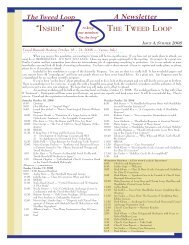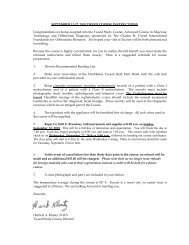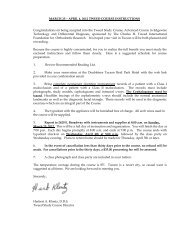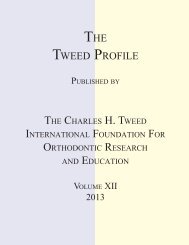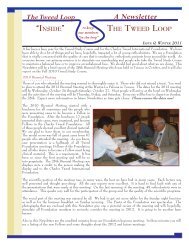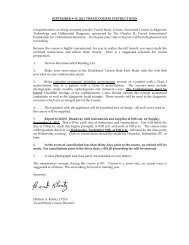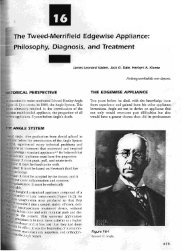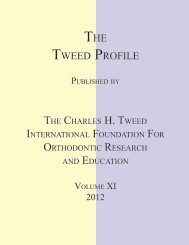published by Volume #8 2009 - The Charles H. Tweed International ...
published by Volume #8 2009 - The Charles H. Tweed International ...
published by Volume #8 2009 - The Charles H. Tweed International ...
- No tags were found...
Create successful ePaper yourself
Turn your PDF publications into a flip-book with our unique Google optimized e-Paper software.
THETWEED PROFILE<strong>published</strong> <strong>by</strong>THE CHARLES H. TWEEDINTERNATIONAL FOUNDATION FORORTHODONTIC RESEARCH AND EDUCATION<strong>Volume</strong> <strong>#8</strong><strong>2009</strong>
GOALS, CONCEPTS, AND GUIDELINES FOR COMPREHENSIVE CORRECTION OFCLASS II MALOCCLUSIONSHERB KLONTZOKLAHOMA CITY, OK<strong>The</strong> Class II malocclusion is a difficult problem for thespecialty of orthodontics. If the practitioner can routinelyand successfully correct Class II malocclusions,he/she generally has a good idea of treatment planningand the proper delivery of force systems. <strong>The</strong>goals that one must establish prior to treatment of anyClass II malocclusion are the same goals that must beachieved during the correction of a less difficult malocclusion.<strong>The</strong>se goals are esthetics, health and function,stability, and treatment in harmony with growth.A good differential diagnosis will lead to a treatmentplan that will insure successful treatment. All treatmentplans, no matter what the malocclusion, shouldbe based on the dimensions of the dentition. This is afundamental concept, and it must not be violated if theresolution of the malocclusionis to be successful. When one istreatment planning the Class IImalocclusion, it is important to“compartmentalize” the variousaspects of the problem into a) theface, b) the skeletal pattern, andc) the dentition. <strong>The</strong> purpose ofthis paper will be to share somediagnostic, treatment planningand force system guidelines thatFig. 1will enable the practitioner to routinely and successfullycorrect the difficult Class II malocclusion.THE FACE - FACES FIRST!!<strong>The</strong> goal of orthodontic treatment is to improve facialbalance, harmony and proportion, or to maintain facialbalance, harmony and proportion. Facial balance canbe quantified <strong>by</strong> the use of Merrifield’s Z angle 1 . Itis an excellent guideline because it allows the orthodontistto quantify the soft tissue response to toothmovement. This patient (Fig. 1) has a very protrusiveClass II facial pattern. <strong>The</strong> initial Z angle is 54º.After treatment with a proper treatment plan and forcesystem, the Z angle is 73º. This young man (Fig. 2)has a pretreatment Z angle of 58º and a posttreatmentZ angle of 76º. <strong>The</strong> correction of his high angle ClassII malocclusion required a well formulated treatmentplan and a force system that paid particular attentionto vertical control during tooth movement.THE SKELETAL PATTERNAn understanding of the skeletal pattern must be anintegral part of any orthodontic treatment plan. It isvery difficult to change the vertical dimension of aparticular patient. <strong>The</strong>refore, for the patient to havegood facial esthetics at the end of orthodontic treat-3
Fig. 10aFig. 12Fig. 10bFig. 13of 30.9 millimeters. A summary of the space requirementsalong with the Class II occlusal disharmony(Fig. 12) illustrates a deficit of 16.4 millimeters in justthe anterior/midarch area. This 16.4 millimeters doesnot include the posterior discrepancy which can beresolved <strong>by</strong> extraction of third molars. <strong>The</strong> clinicianmust find 16.4 millimeters of anterior/midarch mandibularspace to correct this young man’s problem.Fig. 11Patient T.S. was treatment planned for the extractionof the maxillary first premolars and the mandibularsecond premolars. <strong>The</strong> pretreatment/recall facial photographs(Fig. 13) illustrate the drastic and dramaticimprovement in facial esthetics. <strong>The</strong> cephalometic x-rays and the tracings (Fig. 14a, b) confirm the correctionof the malocclusion due to movement of the teeth.FMIA has increased from 59º to 72º. <strong>The</strong> Z angle hasimproved from 66º to 78º. ANB has been reducedfrom 8º to 1º. <strong>The</strong> slides of the teeth after “settling”of the dentition(Fig. 15) illustratea healthy and functionaldentition.Class II correctioncannot be accomplishedwithout aproper treatmentplan and a properforce system, bothof which allow theclinician to takeadvantage of the patient’s genetic potential for the6
Fig. 14aFig. 14bmandible to outgrow the maxilla in a downward andforward direction. <strong>The</strong> pretreatment/recall photographsof patient, T.S. when viewed together (Fig. 16)graphically illustrate what can happen for the Class IIpatient if the “fundamentals” are followed. <strong>The</strong> treatmentgoals of esthetics, health and function, stability,and treatment in harmony with growth were achievedfor this patient. <strong>The</strong>se things could not have been accomplishedhad the patient not been treatment plannedproperly and had not the force systems been deliveredin a very sequential, careful, and controlledmanner.Fig. 15In (Fig.17) are two sets of sisters. Each oneof these young ladies was treated with a differenttreatment plan. Starting from right toleft the treatment plans were: non-premolarextraction, maxillary first premolars/mandibularsecond premolars, four first premolars,four first premolars, maxillary, second molarsand mandibular third molars. All of themhave gorgeous smiles. <strong>The</strong> validation of thetreatment plan and the force system when theClass II patient is treated is the smile!Fig. 16Fig. 17REFERENCEMerrifield, L.L., <strong>The</strong> Profile as an Aid in Critically Evaluating Facial Esthetics, AJO/DO, 1966. 11, page 804-822.7
“IN PURSUIT OF A BEAUTIFUL FACIAL PROFILE”KOHO HASEKITAKAWABE SAITAMA, JAPANINTRODUCTIONDue to differences in genetic make-up, <strong>Tweed</strong>’s FMAand FMIA standards that “work” for the Caucasianpopulation do not necessarily apply for other ethnicgroups. In general, Japanese people tend to have flatternoses, more anterior tooth protrusions and a moredolichocephalic profile than Caucasians (Fig. 1).Fig. 1Fig. 2Fig. 4 - Not long ago gold teeth had been the symbolof wealth and beautyIndeed, during the early 90’s, Japanese movie stars(Fig. 3) with “high canines” were considered to be“lovely” and the “Gold tooth” (Fig. 4) was the symbolof wealth and beauty. <strong>The</strong> Japanese have called themselvesYamato Minzoku (peace people) and have longbeen affected <strong>by</strong> the philosophy of Zen, that requiresa spirit of acceptance of all nature. <strong>The</strong>refore manyJapanese people might not criticize or discuss the matterof facial esthetics in public, or even in private.After seeing the traditional Japanese dancing girl, theGeisha, (Fig. 2) Westerners might ask “What is theperception of Japanese facial beauty?” Is there anydifference between Japanese and western perceptions?Our generation has changed its perception of facialbeauty. Caucasian stars like Hilary Duff, and CameronDiaz are very popular in Japan. <strong>The</strong>ir lovelyfacial beauty is quite acceptable.(Fig. 5) One of themost popular young Japanese movie stars is Miss UetoAya (Fig. 6). Her lateral profile was examined and itFig. 3- Early 1990’s stars with high canine wereconsidered to be “lovely”Fig. 58
was found that she has anIMPA of 88°. Althoughthe profile of a Japanese isdifferent than the “Westernprofile”, the perceptionof good facial esthetics isvirtually the same. Fig. 6MATERIALS & METHODS<strong>The</strong> data from 80 patients treated with <strong>Tweed</strong> Merrifieldmechanics was studied and analyzed. <strong>The</strong>se80 patients, over the course of the past 13 years, haveenjoyed the success of the orthodontic treatment andare happy with their facial profiles.In the sample are 27 Angle’s Class I malocclusions,36 Angle’s Class II malocclusions and 17 Class IIImalocclusions. Lateralcephalogramsand study casts weremeasured. <strong>The</strong> cephalogrammeasurementswere performed <strong>by</strong>either traditional X-rayfilm tracing and/or <strong>by</strong>the software “AutoFig. 7- Nose protrusion rate =length of nose tip to SN/lengthof SNCad”. To know thedeviation rate of thelength of nose tip toSN line, a measurementwas made and the “protrusion rate of nose tip toSN” was calculated <strong>by</strong> the following equation (Fig. 7)Protrusion rate of nose tip to SN= Length of the nosetip to SN / Length of SN (%)(Fig. 8).<strong>The</strong> average pretreatment values of the 63 Class I malocclusionsand Class II malocclusions in the samplebefore treatment were: FMIA 50.73°, FMA 33.67°,and IMPA 95.60°. <strong>The</strong> values of the 17 Class IIImalocclusion sample were: FMIA 59.53, FMA 32.35°,and IMPA 90.08°. After the treatment, the averagevalue of the 63 Class I and Class II malocclusions improvedto the following measurements: FMIA 57.97°,FMA 34.10°, and IMPA 87.98°. <strong>The</strong> Class III groupsaw improvements to FMIA 67.35 , FMA 32.88°,and IMPA 82.17°. <strong>The</strong> IMPA of Class I and Class IIResultHase Dental Class I & II — 63 Samples<strong>Tweed</strong> Value Before After DifferenceFMIA 67 50.73 57.97 7.24FMA 25 33.67 34.10 0.43IMPA 8895.60 87.98 -7.61SD4.3SNA 82 82.34 81.48 -0.86SNB 80 76.80 77.23 0.43ANB 2 5.54 4.25 -1.30AO-BO 2mm 1.93 1.50 -0.43OCC PLANE 10 13.91 13.11 -0.8Z ANGLE 75 56.58 67.51 10.94FAC. HT. INDEX .67 0.68 0.01Fig. 8Hase Dental Class III — 17 Samples<strong>Tweed</strong> Value Before After DifferenceFMIA 67 59.53 67.35 7.82FMA 25 32.35 32.88 0.53IMPA 88 90.08 82.17 -7.92SNA 82 80.35 82.12 1.76SNB 80 78.97 80.65 1.68ANB 2 0.76 0.89 0.13AO-BO 2mm 4.35 0.82 3.53OCC PLANE 10 11.47 10.24 1.24Z ANGLE 75 70.47 75.24 4.76FAC. HT. INDEX 0.69 0.69 0.00Fig. 9samples decreased 7.6° with a SD of 4.3°. Even theClass III sample, which always requires an uprightIMPA for dentition correction, had an IMPA decreaseof 7.92° (Fig. 9).<strong>The</strong> protrusion rate of the nose tip to SN for Japaneseand Caucasian Clinical Norm Bioprogressive Diagnosis,<strong>by</strong> Nezu et. al is 43% and 52% respectively. <strong>The</strong>average Length of nose tip to SN is 28mm and 52mmrespectively. In my clinic the protrusion rate for thepre. and post treatment patients was 44% ( SDTEV4.2%) and 45% respectively.9
<strong>The</strong> average length of nose tip to SN is 27.4mm (Pre.)and 28.7mm (post.) respectively. <strong>The</strong>re was a 1.3mmincrease due to orthodontic treatment (Fig. 7).All the patients and their parents were satisfied withthe improved facial balance and harmony. <strong>The</strong>re aretwo samples (Fig. 10 - 17) who have similar pretreatmentand posttreatment cephalometric values thatcorrespond with the average for the Class I and ClassII malocclusion samples.Fig. 13 - Five years after debandedFig. 10 - Case 1 “Standard Japanesemalocclusion” Age:14Treatment period: 36 monthsFig. 14 - Case 2 “Standard Japanesemalocclusion” Age:14Treatment period: 17 monthsFig. 11 - Pretreatment Class II Bimaxillary ProtrusionFig. 15 - Pretreatment Class II deep biteFig. 12 - Posttreatment Class II Bimaxillary ProtrusionFig. 16 - Three years after debanded10
Hase Dental Class I & II — 63 SamplesBefore After ImprovementFMIA 50.73 57.97 7.24FMA 33.67 34.10 0.43IMPA 95.60 87.98 -7.61(-8.79 away from Japan Norm 96.8)Fig. 17 - PosttreatmentDISCUSSIONIn our world, the cultural differences between countriesare becoming less and less evident due to masscommunication. This “borderless” phenomenon hasbeen a strong trend among Japan’s “young” generation.<strong>The</strong> Japanese perception of beauty of the facialprofile is becoming closer to that of the Caucasian. Itis inevitable and necessary to consider the facial profileduring orthodontic treatment, especially becauseof this new sense of what is considered beautiful.In the 1950’s <strong>Tweed</strong>’s sample of 95 patients was selectedon the basis of good facial esthetics. <strong>The</strong> samplehad an incisor mandibular plane angle (IMPA) of87.88° which is 3.52° less than the average of 91.4°,a “norm” used <strong>by</strong> Down’s in his study of a Caucasiansample. Compared to Caucasians, the Japanese havehigher FMA values. <strong>The</strong> samples of Class I and IIwho came to my office showed average FMA valuesof 33.67° and an IMPA 95.60° before treatment.<strong>The</strong>se two values quite matched the malocclusionvalues of FMA 34.02° and IMPA 94.49° which areJapanese measurements done <strong>by</strong> Iwasawa’s 1969 teamat Japan University. In this study, <strong>by</strong> using <strong>Tweed</strong>Merrifield Mechanics, I have improved the patient’sIMPA from the average of 95.60° to 87.98° which isalmost 8.79° less than the average Japanese IMPAvalue of 96.77° (Iwasawa Fig. 18, 19). <strong>The</strong> improvedIMPA value is almost the same as the IMPA value Dr.<strong>Tweed</strong> decided should be the standard 50 years ago.It is worthwhile to note that the initial Japanese FMAand FMIA values were quite different from <strong>Tweed</strong>’sstandard value. <strong>The</strong>re were two high angle patients inHase Dental Class III — 17 SamplesBefore After ImprovementFMIA 59.53 67.35 7.82FMA 32.35 32.88 .53IMPA 90.08 82.17 -7.92<strong>Tweed</strong> Formula for Head film correction: ifFMA 35 34FMIA 65 65IMPA 80 81Fig. 18- Compensating the inclination of themandibular incisors for varying FMAFig. 19 Despite different genetic makeup - High FMAangle the IMPA was able to achieve uprightness to thevalue of IMPA 88 (87.98) and good facial estheticsFig. 20 - IMPA of 88°the sample who were treated to an IMPA of 88° (Fig.20-29) and four other patients for whom the treatmentcreated improvement of facial esthetics due to theIMPA of 88° (Fig. 30-33).11
Pre PostFMIA 39 49FMA 45 43IMPA 96 88SNA 80 75SNB 71 71ANB 9 4AO-BO 8 50CC 23 20Z 48 60UL 14 13TC 16 14PFH 40 47AFH 70 68INDEX .58 .69Fig. 24Fig. 21 - Pretreatment and Posttreatment measurementsFig. 25Fig. 22Fig. 26Fig. 2312
Pre PostFMIA 39 46FMA 48 46IMPA 93 88SNA 82 82SNB 76 76ANB 6 6AO-BO -1 40CC 23 18Z 54 63UL 12 10TC 15 14PFH 53 50AFH 82 80INDEX .65 .62Fig. 27Fig. 30Fig. 28Fig. 31Fig. 29 - Two years after debanding13
CONCLUSIONDue to the Japanese population having a high FMAvalue, the use of <strong>Tweed</strong> Merrifield Mechanics has tofocus on the IMPA rather than the FMIA.1.2.3.<strong>The</strong> change in the IMPA angle should be limitedto be around 7.6° SD±4.3 to 7.9°, therefore the<strong>Tweed</strong> Cephalometric correction Formula is notquite as appropriate for the high angle Japanesepatient.Strategically implementing ways to reach anIMPA of 88°during the initial stages of treatmentwill lead to success and to good esthetics.An IMPA of 88° will “guarantee” good facialesthetics for most Japanese people.Fig. 32 - Nose protrusion rate 46% to 47%(Caucasian norm 52%)Fig. 33 - Nose protrusion rate 43%(Caucasian norm 52%)14
ESTHETICS AND DIRECTIONAL FORCES IN PATIENTS TREATED IN TWO PHASESMARIA GIACINTA PAOLONEROME, ITALY<strong>The</strong> increased awareness of craniofacial growth andthe possibility of using growth as an “orthodonticappliance” offers the opportunity of treating youngerpatients. <strong>The</strong> opportunity to treat younger patientsrequires the orthodontist to understand that he/she istreating not only teeth, but growing faces. Orthodonticsis changing facial balance and harmony in childrenwho are preparing to become adults. So, whichdirection should the face be moved? Or, better, whichdirection should growth be moved? Growth can be anorthodontic appliance.<strong>The</strong> plan of treatment in younger children must takeinto account the effects of “growth”. Is growth free toexpress itself or is there any necessity to give a newdirection, a new freedom? Is the natural growth ofthe patient in the direction of the correction needed?Are there any interferences or dental compensationsthat might be able to push the face towards a pathwaywhich guarantees future facial esthetics, function andstability?orthodontic appliances in order to work on dentalcompensations, the cant of the occlusal plane, andfunctional interferences. This type of treatment willprepare the patient for a second phase treatment inwhich growth is already “redirected” and ready tocontribute pure directional forces which is guaranteed<strong>by</strong> <strong>Tweed</strong> mechanics.<strong>The</strong> following clinical case reports illustrate this concept.Merrifield L:L:; Cross J:J:: Directional forces. Am JOrthod 1970; 57(5): 435-463One’s mechanical directional forces must be in completeharmony with the patient’s growth so that growthcan have free “expression” without obstacles, interferencesand compensations. In this situation two phasesof treatment might allow clinicians to detect and treat,as early as possible, the direction of the growth with15
Patient 1: This patient has an Angle’s Class II occlusion and bilateral posterior crossbites.16
Patient 1: <strong>The</strong> palatal construction is corrected.17
Patient 1: <strong>The</strong> posttreatment face and teeth.18
Patient 1: Recall face and teeth.19
Patient 2 – Pretreatment: Palatal constriction and a tooth arch discrepancy.20
Patient 2 – Posttreatment: <strong>The</strong> face and the teeth.21
Patient 2 – Recall: <strong>The</strong> face and the teeth.22
Daniel GeorgeHOLLAND, MITHE USE OF TEMPORARY ANCHORAGE DEVICES (“TAD’S”)IN TWEED-MERRIFIELD DIRECTIONAL FORCE ORTHODONTICS<strong>The</strong> purpose of this presentation is to illustrate the useof technology that can help us achieve our treatmentgoals. Over the past several years, an alternative, adjunctiveappliance, the Temporary Anchorage Device(TAD) has arrived. It is now possible to prepare theideal mandibular arch and not compromise it, as wellas to correct the Class II or Class III malocclusion <strong>by</strong>using TAD’s for skeletal anchorage.TAD’s can provide virtually 100% skeletal anchorage.<strong>The</strong>y help increase control in all three planes of space.It is possible to retract, protract, intrude, upright impactedteeth, etc., without patient cooperation. TAD’shave also reduced the need for orthognathic surgery tocorrect some skeletal dysplasia’s. In some instancesTAD’s eliminate implants to replace congenitallymissing teeth — such as mandibular second premolars.Fig.1a: Absolute maxillaryincisor intrusion using TAD’s.Note difference on occlusal planeof incisors to cuspids.TAD’s can be used to intrude teeth (Fig. 1a, b). <strong>The</strong>maxillary canine to canine segment can be intrudedand retracted simultaneously. Treatment time is reduced(Fig. 2a, b).It is possible to distalize the maxillary arch as far asnecessary without the use of headgear (Fig. 3a, b).Fig. 2b: Immediately Post-retractionof the canine to canine segment.Fig. 2a: TAD’s used toretract and intrude theanterior segment. A newway to reduce treatmenttime in a controlled manner.Fig. 1b: Post treatment occlusion.23
Fig. 3a: Distal “en masse” movementwith 1.5mm x 9.0mm TADand 250g Niti spring.Fig. 3b: 5 months later. Note theneed for constant, active lingualroot torque in the maxillary incisorsduring distal en masse forceapplication in order to preventlingual crown inclination.One can retract the mandibular arch to upright mandibularincisors to the desired position without headgearor Class III elastics (Fig. 4a, b, c).Open bite patients can be treated <strong>by</strong> intrusion of maxillary(or mandibular) posterior teeth without usingthe unstable biomechanics of extruding maxillary andmandibular anterior teeth to close the bite (Fig. 5).<strong>The</strong>se are just some of the possibilities of how TAD’scan help orthodontics. TAD’s help eliminate thepatient compliance issue and can reduce the need forheadgear, elastics, and other non-compliant therapies.Fig. 4a: Class III with TAD’s in the Oblique Ridge to retract the mandibulararch.Fig. 4b: Mandibular arch distal en masse movement.Fig. 4c: Radiograph of mandibular TAD’s in theOblique Ridge.Fig. 5: Open bite closure with TAD’s. Note: No upper anterior brackets to prove the bite was closed with upperposterior intrusion only.24
EXTRACTION OF A MANDIBULAR INCISOR IN ADULT ORTHODONTIC TREATMENT:AN ACCEPTABLE COMPROMISE?GIOVANNI BIONDIVARAGO DI MASERADA (TV), ITALYDuring orthodontic treatment of adults, compromisecan be a daily necessity. Extraction of a mandibularincisor is a compromise extraction choice for somepatients. <strong>The</strong> aim of this study was to determine theconditions in which this kind of compromise can bedeemed acceptable.MATERIAL AND METHODA rapid review of the literature revealed that, as farback as 1959, Berger 1 was questioning the wisdom ofextracting a mandibular incisor to treat patients withconsiderable mandibular dental crowding. Richardson 2in 1963 and Levin 3 in the following year raised thesame question. In 1975, Brand and Safirestein 4 followed<strong>by</strong> Bahremann 5 in 1977 presented a series of indicationsfor which extraction of a mandibular incisorcould be regarded as the treatment of choice: thereforea shift occurred from “therapeutic compromise” to“therapeutic indication”.In 1984, Kokich and Shapiro 6 wrote: “…although theindications for this type of extraction are relativelyrare, the possibility of mandibular incisor extractionshould be a part of every clinician’s portfolio of treatmenttechniques. If it is carefully planned and executedin the proper situation, mandibular incisor extractioncan be an effective way of satisfying a particularset of treatment objectives”.By subsequently analyzing the records of our patients,we noted that, out of 3,925 patients in our practice, the85 patients who had been treated with extraction of amandibular incisor represented 2.16% of our patients.However, when we analysed the group of 1,438 adultpatients, the percentage of patients who had an withextraction of a mandibular incisor increased to 5.91%and even reached 14.46% if one took into considerationonly the 588 adult patients for whom extractionwas mandatory.Hence Kokich’s use of the terms “relatively rare”makes sense and, in relation to the “proper situation”(Kokich’s words once again), one can mention Bahremann’sarticle in which he advocates the extractionof a mandibular incisor as the first therapeutic choicein “…Class I malocclusions with normal maxillarydentition and a good buccal interdigitation, whichshow arch length deficiency in the mandibular anteriorsegment of over 4 to 5mm and an anterior ratio greaterthan 0.83 are the cases of first choice for extraction ofone mandibular incisor.”By using this concept and <strong>by</strong> observing our own patientpool, we looked for the dental and cephalometricparameters of the 85 patients treated with extraction ofa mandibular incisor.Cephalometric parameters were (Table 1):• FMA: the value ranged between 16° and 33° withan average of 24.88° (normodivergent)• IMPA: the value ranged between 88° and 103°with an average of 93.08° (incisor slightly tippedon its bony base)• ANB: the value ranged between -2° and 6° with anaverage of 2.29° (skeletal Class I)25
Table 1: Cephalometric ParametersFMA 24.88 Range 16 33IMPA 93.08 88 103ANB 2.29 -2 6From the occlusal point of view, Bahremann considersthat the best results are obtained when antero-inferiorcrowding is 4 to 5mm and with an anterior Boltonindex greater than 0.83. By the analyzing these twoparameters of our 85 patients (Table 2), we obtaineda mean anterior crowding score of 5.38mm (normbetween 3 and 8mm) and a mean Bolton index of 0.79(norm between 0.74 and 0.86). <strong>The</strong>se results showcrowding at the upper limit of that indicated <strong>by</strong> Bahremannand, conversely, a Bolton index slightly higherthan that considered optimal <strong>by</strong> the same author forextraction of a mandibular incisor (even if it is beyondthe upper limit of 0.772 considered as an ideal standard).Of course, the highest Bolton indices correspondto better posttreatment overjets (Fig. 1).Fig. 2Fig. 3Fig. 1Table 2: Dental – 85 PatientsCrowding 5.38 Range 3 8Bolton Index 79.02 74 86Once the decision has been made to treat a patient<strong>by</strong> extracting a mandibular incisor, it is important todetermine which incisor should be extracted. Bahremann,the author who has contributed the most tocodifying the choice for this type of treatment, advocatesfour factors that need to be kept in mind:••••amount of mandibular anterior arch length deficiency(Fig. 2)amount of anterior root ratio (Fig. 3)periodontal and tooth health condition (Fig. 4)maxillary and mandibular midline relationship(Fig. 5)Fig. 4Our experience has led us toadd another factor to this list,namely, incisor axis (Fig. 6).In similar periodontal or endodonticsituations, the choiceof extraction will involve theincisor which will best facilitateuprighting of the remainingthree incisors. It is thereforeimportant to carefullyFig. 5examine the axes of the teethwithout being influenced exclusively <strong>by</strong> crowdingbecause to do so might lead one to extract the tooth26
Fig. 6•••••Fig. 8skeletal Class I (or dental Class III)normodivergence of the bone baseantero-inferior crowding ranging between 4 and5mma high Bolton index (ideally above 0.83)a judicious choice of the incisor to be extractedbearing in mind periodontal and endodontic health,as well as the axes and the shapes of the incisors.Fig. 7which has been pushed furthest outside the limit of theincisal arch (Fig. 7). When closing spaces, a poor axialinclination choice could make it more difficult to correctrotations and upright the other incisor.Finally, to achieve the best final result, it is essential toestimate the shape of the incisors (Fig. 8). It is importantto bear in mind that some incisors have a mesio-distaldiameter at the incisal edge which is muchgreater than the diameter at the incisor neck (more“triangular” crowns). This tooth morphology will promotethe emergence of dark gaps at the papilla level.This negative esthetic factor will be less evident withincisors which have approximately similar measurementsat the incisal edge and neck (more “rectangular”teeth)RESULTS AND CONCLUSION<strong>The</strong> answer to the initial question about whetherextraction of a mandibular incisor can offer an acceptablecompromise choice in adult orthodontic treatmentcan definitely be answered in the affirmative. Observationof clinical results and analysis of the values oftreated patients with the best results confirm the validityof this treatment option. <strong>The</strong> option is valid in sofar as the following conditions are respected:Similarly, one can consider this choice as being contraindicatedfor patients who present with problemsin the vertical dimension, a bialveolar protrusion orcrowding that requires extraction of other teeth.REFERENCES1.2.3.4.5.6.H. Berger Some considerations regarding mandibular incisorcrowding and its treatment, TRANSACTIONS OF THEEUROPEAN SOCIETY FOR THE STUDY OF ORTHO-DONTICS 1959.ME. Richardson Extraction of mandibular incisor in orthodontictreatment planning, DENTAL PRACTITIONER 14,1963.S. Levin An indication for three incisor case, ANGLE OR-THOD 36, 1964.S. Brandt, R. Safirestein Different extractions for differentmalocclusions, AM J ORTHOD 68, 1975.AA. Bahremann Mandibular incisor extraction in orthodontictreatment, AM J ORTHOD 72, 1977.VG. Kokich, PA Shapiro Mandibular incisor extraction inorthodontic treatment, ANGLE ORTHOD 54, 1984.ADDITIONAL SUGGESTED READING• JT. Dacre <strong>The</strong> long term effects of one mandibular incisorextraction EUR J ORTHOD 7, 1985.• RA. Riedel, RM. Little Mandibular incisor extraction.Postretention evaluation of stability and relapse ANGLEORTHOD 62, 1992.• E. Faerovig, BU. Zachrisson Effects of mandibular incisorextraction on anterior occlusion in adults with class III malocclusionand reduced overbite, AMJ ORTHOD 115, 1999.27
molars was Angle’s Class II. Although clicking wasnoted in the left joint during opening, the patient couldopen more than 40mm and had no spontaneous pain ortenderness on motion. (Fig. 4)<strong>The</strong> initial orthopantomogram showed a small amountsuggested that the Cranial Facial Difficulty Total of137 was attributable to unfavorable positions of themaxilla and mandible in the horizontal and verticalplanes.Normal RangeCeph.ValueDifficultyFactorFNA 22-28 31.5 5 17.5DifficultyANB 1-5 8.0 15 45.0Z-ANGLE 70-80 54.0 3 32.0Fig. 4of horizontal bone loss around the maxillary anteriorteeth and a distally inclined and impacted mandibularright third molar. <strong>The</strong> maxillary and mandibular rightfirst molars and the maxillary right second premolarwere nonvital. <strong>The</strong>re was a periapical lesion aroundthe mesial root of the mandibular right first molar butthere were no subjective or objective symptoms.ANALYSISMany pretreatment cephalometric measurements (Fig.5) were outside the normal range: FMIA 45.5°, FMA31.5°, IMPA 103°, SNB 75.5°, ANB 8°, AO-BO11mm, Z-angle 54°, Posterior Facial Height 38mm,Anterior Facial Height 69mm and Facial HeightIndex 0.55. <strong>The</strong> Cranial Facial Analysis (Fig. 6) hada difficulty total of 137. <strong>The</strong> Space Analysis total wasFig. 549.0mm but the Space Analysis Difficulty total was53.5mm. <strong>The</strong> Total Difficulty was 190.5, an indicationthat the malocclusion was severe. A detailed studyOCC. PLANE 8-12 11.0 3 0.0SNB 78-82 75.5 5 12.5PFH/AFH 0.65-0.75 .55 3 30.0C.F. Difficulty Total 137.0Fig. 6<strong>The</strong>re was also a Bolton tooth-size problem. <strong>The</strong> sizesof the mandibular teeth from central incisor to firstmolar were larger than those for the respective normativemeans. <strong>The</strong> anterior ratio was 84.12% greater thanthe normative mean plus its 2.8 SD. <strong>The</strong> overall ratiowas even higher, 98.35%, which was greater than thenormative mean plus its 3.3 SD.DIAGNOSIS, TREATMENT OBJECTIVESAND TREATMENT PLANNING<strong>The</strong> patient was diagnosed as a Class II, division 1deep overbite malocclusion with tooth size discrepancy.<strong>The</strong> treatment objectives were to eliminate crowding,resolve the tooth size discrepancy, level the curveof Spee, establish proper overjet and overbite, createsolid intercuspation and achieve a balanced facialprofile.Prior to developing a treatment plan, “setup” casts(Fig. 7) were constructed in order to make the optimalextraction decision. As a result, the extraction of twomaxillary first premolars, a mandibular right third molarand mandibular right central incisor was found tobe optimal for the achievement of the treatment goals.29
obicularis oris and mentalis muscles on lip closuredisappeared. <strong>The</strong> opening click in the left joint resolved.<strong>The</strong> final intraoral photographs (Fig. 9) showthat the same occlusion as predicted with the pretreatment“setup” casts was obtained. Favorable changeswere produced cephalometrically: FMIA from 45.5°to 51.0°, FMA from 31.5° to 31.0°, IMPA from 103°to 98°, AO-BO from 11.0mm to 5.5mm and Z Anglefrom 54.0° to 66.0°. (Fig. 10, Fig. 11) <strong>The</strong> overjet andoverbite were also improved from 11mm to 4mm andFig. 7<strong>The</strong> molar relationship would remain an Angle’s ClassII at the end of treatment.It was explained to the patient, using the figures of theCranial Facial Analysis, that her malocclusion wouldbe extremely difficult to treat with orthodontics alone.Based on the information from the “setup” casts, acombination of orthodontic treatment with extractionof two maxillary first premolars, the mandibular rightthird molar and central incisor along with a maxillaryanterior alveolar segmental osteotomy was proposed.<strong>The</strong> patient refused this plan because she could notafford hospitalization for orthognathic surgery. Analternative plan of treatment with extraction of themaxillary first premolars, and the mandibular rightcentral incisor along with the use of a high-pull J hookheadgear to both maxilla and mandible was presented.This plan was accepted <strong>by</strong> the patient.Fig. 95mm to 4mm, respectively (Fig. 12). <strong>The</strong> superimpositionof pretreatment and posttreatment cephalometrictracings (Fig. 13) showed that the maxillary firstmolar was intruded 2mm and moved mesially 2mmwhile the mandibular first molar was distally uprighted1mm. <strong>The</strong> result was a counterclockwise rotationof the mandible.TREATMENT RESULTSAfter active treatment and 2 years of retention, theconvex profile with a protrusive upper lip and aneverted lower lip was improved to a balanced facialand lip profile. (Fig. 8) <strong>The</strong> severe strains of theFig. 10Fig. 830
Fig. 11Fig. 12Fig. 1331
TWEED-MERRIFIELD PHILOSOPHY: SOME CLINICAL DETERMINATIONS FORTHE ADULT PATIENT TREATMENTSERGIO A. CARDIEL RÍOSMORELIA, MICHOACÁN, MEXICOOrthodontic management of the adult patient frequentlydiffers from the young patient since manyadult patients have dental decay, missing teeth, poorbridges, unesthetic restorations and TMJ disorders aswell as certain types of periodontal disease.This case report illustrates the benefits of integratingorthodontics and other dental disciplines in the managementof adult patients who have underlying dentaldecay and periodontal defects. <strong>The</strong> key to treatingthese patients is communication and a proper treatmentplan before orthodontic therapy as well as a continueddialogue with the multidisciplinary team duringorthodontic treatment.Fig. 1CASE DESCRIPTION<strong>The</strong> case report of a 24-year old Mexican patientis presented. He had a class II division 1 malocclusionwith a negative medical history. <strong>The</strong> patient’scomplaint was that he exhibited an unesthetic dentalappearance when smiling and he had some discomfortwhen chewing. A “deficient” chin was also consideredwhen evaluating the patient’s facial balance (Fig.1).Intraoral views showed both midlines deviated dueto the missing maxillary canines and the mandibularright first molar. Gingival recession was present,particularly on the mandibular canines and premolars.An unesthetic crown was present on the maxillaryleft lateral incisor. Moderate anterior crowding wasevident (Fig. 2).Fig. 233
<strong>The</strong> panoramic radiograph showed considerabledivergence in root parallelism, the presence of maxillarythird molars and the impacted mandibular leftthird molar. According to the periodontist, the patientshowed acceptable bone levels except in edentulousareas (Fig. 3).Fig. 3Cephalometrically, his maxillo-mandibular relationshipwas retrognathic SNB (77°). His FMA (29°) andFHI (72°) confirm a, normal vertical skeletal pattern.Occlusal plane (16°) was high but the Z angle (67°)was close to normal (Fig. 4).Fig. 5Fig. 4Since the patient had gingival recession on the mandibularcanines, mild recession on some premolars,poor gingival margin heights and a questionablebridge in the maxilla, a multidisciplinary team approachwas required.DIAGNOSIS AND TREATMENT PLANNING<strong>Tweed</strong>-Merrifield diagnosis and treatment philosophyis designed to give maximum facial and dental esthetics,maximum functional efficiency, optimal healthof teeth and surrounding tissues, and long term stabilityfor each patient. To realize these goals requires asound and careful treatment plan. <strong>The</strong> craniofacialand dental analysis had a total difficulty index score of66.5.<strong>The</strong> dental problems had to be solved as did the periodontalproblems. <strong>The</strong> mandibular incisors had to beplaced in their proper positions. Space in the edentulousareas had to be managed so that the dental restorationscould be placed. (Figs. 5 and 6). <strong>The</strong> treatmentplan required the extraction of maxillary third molars,the mandibular left third molar and the mandibularcanines. <strong>The</strong> bridge replacing the maxillary teeth hadto be removed prior of placing orthodontic appliances.34
Pre Restorative PhaseMaxillary lateral incisors were carefully managedin order to consider a morphologic mesio-distal relationshipin shape, proportion, width and length forthe future prosthetic restorations. <strong>The</strong> dentist placedlaminate veneers during the retention period once gingivalrecontouring was done and gingival health wasassured. <strong>The</strong> maxillary and mandibular first premolarswere reshaped with a bur to give them a “canine appearance”(Fig. 6).Post Restorative PhaseRESULTS<strong>The</strong> face shows harmony and balance. <strong>The</strong> smile lineand buccal corridors have improved as has the noselip-chinspatial relationship (Figs. 7, 8, 12 and 13).Teeth and gingiva are healthy and esthetic. Good “architecture”of the gingival complex is evident. A ClassI occlusion on both sides was achieved along withproper “canine” guidance. <strong>The</strong> occlusal plane wascontrolled (Figs. 2, 8 and 10). Overbite and overjetare ideal, thus providing for optimal anterior guidance(Fig. 8).Fig. 6Mechanotherapy was designed so that <strong>Tweed</strong>-MerrifieldClass II mechanics could be used to distalizethe maxillary teeth to obtain a Class I occlusion andimprove the intercuspation of the teeth. <strong>The</strong> mandibulararch required space management of crowded teeth.<strong>The</strong> mandibular right molars were carefully uprightedand moved mesially. Patient cooperation was excellent.Treatment time was 39 months.Periodontal concerns were considered during a carefulpreorthodontic evaluation, and the periodontist agreedto begin orthodontic treatment prior to periodontaltherapy. However, he recontoured the gingival marginsto a more ideal level before prosthetic restorationson the maxillary lateral incisors. <strong>The</strong> periodontist alsodid a supracrestal fiberotomy from premolar to premolarin both arches three months prior to the removal oforthodontic appliances. <strong>The</strong> patient was periodicallyexamined during orthodontic treatment to evaluateoral hygiene and tissue conditions (Fig. 5).Fig. 7Fig. 835
Fig. 13<strong>The</strong> panoramic radiograph shows acceptable rootparallelism with good health of the roots and thealveolar bone (Fig. 9).<strong>The</strong> cephalometric tracingconfirms maxillo-mandibular and dental changes.Control of FMA, ANB and facial height is confirmed.Merrifield’s Z angle quantified the harmony, balanceand improvement of the face (Figs. 10, 11 and 13).Superimposition on S-N verifies vertical control of themaxillo-mandibular complex since teeth were movedwith vertical, sagittal and transverse control (Fig. 11).REFERENCES1.2.3.4.5.6.7.8.Kokich, V.: Esthetics and Anterior Tooth Position: An Orthodontic Perspective, Part I: Crown Length; Part II: Vertical Position;Part III: Mediolateral Relationships, J. Esth. Dent. 5:19-23, 174-178, 200-207, 1993.Kokich, V.: Esthetics: <strong>The</strong> Orthodontic- Periodontic- Restorative Connection. Semin. Orthod. 2:21-30. 1996.Mathews, D.P., Kokich,V.: Managing Treatment for the Orthodontic Patient with Periodontal Problems. Semin. Orthod.. 3:21-28,1997.Gartrell, J.G., Mathews, d.p.: Gingival Recession: <strong>The</strong> Condition, Process and Treatment. Dental Clin. North AM., 1:199-213,1976.Vanarsdall,R.L.: Periodontal Problems Associated with Orthodontic Treatment. In Barrer H. Editor: Orthodontics: <strong>The</strong> State ofthe Art, Philadelphia, 1981.Vanarsdall, R.L.: Periodontal Considerations in Corrective Orthodontics. In Clark JW Editor: Clinical Dentistry, Vol 2, Hagerstown,MD, 1978, Harper & Row.Kokich, V., Nappen, D., Shapiro,P.: Gingival Contour and Clinical Crown Length: <strong>The</strong>ir Effect on the Esthetic Appearance onMaxillary Anterior Teeth. AJO. 86:89-94,1984.Edwards, J.: A Surgical Procedure to Eliminate Rotational Relapse. AJO 57:35, 1970.37
GIVE ME BRACES, AND I’LL GIVE YOU BONE!ELIE WILLIAM AMMBEIRUT, LEBANONCurrent practice trends for treatment of alveolar bonedeficiency before implant placement advocate surgicalprocedures such as bone grafting, GBR, distractionosteogenesis, etc. However, the usefulness of orthodontictooth movement in generating alveolar boneand soft tissue suitable for implant placement may beunderestimated, even when properly indicated andwhen traditional ways have their limitations.This paper will attempt to point out the advantages oforthodontics in implant site development <strong>by</strong> selectedexamples of vertical and horizontal alveolar bone deficiency,and outline its indications.Patient # 1. Orthodontic extraction:A 28 years old man came to the periodontist’s officewith acrylic “gum” around tooth numbers 23 and 24(Fig. 1a). <strong>The</strong> problems caused <strong>by</strong> the splint werevertical gingival recession (Fig. 1b) and bone loss toalmost 2/3rd of the bicuspid root (Fig. 1c).Fig. 2: orthodontic extraction: a. day1─b. 3months─c. 14 monthsalternate proposal was orthodontic extrusion of #’s 23and 24 until their extraction (Fig. 2 a, b, c).During this type of orthodontic “extraction”, teethbring with them new bone suitable for implant placement(Fig. 3a, b, c) and attached gingival. New boneand more gingiva are very difficult to obtain <strong>by</strong> surgery(Fig. 4a, b).Fig. 3: a. bone augmentation in height on x-ray– b. bone volume in situ c. implants placementFig. 1a: “fake gum ─b: gingival recession ─c: vertical bonedefect<strong>The</strong> periodontist advocated the extraction of # 23 and24 followed <strong>by</strong> bone grafting before implant placement.But the defect was very large and the prognosisof such a procedure is poor, especially when stretchingthe gingival soft tissue to cover the bone graft. AnFig. 4: favorable soft tissue profile – a. temporary crowns sixweeks after surgery – b. 2 years later with final crowns39
Fig. 5: a. extraoral and intraoral photographs showing lip incompetence and generalized spaces – b. x-rayshowing fractured right central incisor.Fig. 6: a. endodontic treatment of the apical fragment – b. orthodontic extrusion of the apical fragment – c.central incisor inset to guide the extrusion axis in the alveolar bonePATIENT # 2. ORTHODONTIC EXTRUSIONA 12 year old boy visited his dentist for his fracturedcentral incisor. He also asked for orthodontic treatmentbecause of his lip incompetence and the spacesbetween the teeth (Fig. 5). <strong>The</strong> fracture line was in theapical third of the root (Fig. 5), so the dentist proposedthe extraction of the tooth and its replacement <strong>by</strong> animplant after bone maturity. <strong>The</strong> problem with thissuggested protocol would manifest itself in the futureat the time of implant placement; alveolar bone willbe resorbed during the latent period while waiting forbone maturity. Since the patient needed orthodontictreatment, in order to preserve alveolar bone heightand volume as well as attached gingiva (Fig. 6), endodontictreatment (Fig. 7), and orthodontic extrusionof the apical third of the root was proposed. Premolarextraction would give good results in most patientswith the same pattern but in this patient further extractionswere avoided because the patient was alreadymissing a central incisor. With the help of directionalforce system and J-hook headgear, the results are satisfying(Fig. 8).PATIENT # 3. ORTHODONTIC DISTAL MOVEMENT:A 20 year old lady was referred <strong>by</strong> her periodontist.She underwent earlier orthodontic treatment, and theimplant site for #45 and #46 was managed (Fig. 9).40
Fig. 7: a. height of the bone gained after orthodontic extrusion – b. height ofthe attached gingiva gained and soft tissue profile with 2 to 3 mm of overcorrectionto be used <strong>by</strong> the periodontist at the time of implant placementfor better esthetics.Fig. 8: extraoral and intraoral photographs after orthodontictreatmentButthe periodontist was facing three major problems (Fig.10): a.) narrow crestal bone that required major surgeryfor its enlargement b.) a large mesio-distal spacethat was too large for one implant and too small fortwo implants, and c.) a mental foramen position thatnecessitated a short implant, or an attempt to avoid thearea entirely and place the implant in the middle of theFig. 11: a. lateral view for distalising 44. b. Occlusal view showingthe thickness and volume of the crestal ridge mesila to 44.c- d. implant placement in site of 44. e. x-ray of the implant inplace avoiding the mental foramen.Fig. 9: Intraoral photographs after previous orthodontic treatment.Note the space left for implants to replace 45 an 46.Fig. 10: Occlusal view and x-ray showing the difficulties beforeimplant placement.for replacement of his missing teeth, mainly those inthe maxillary posterior region. He presented with aclass III skeletal pattern (Fig. 12) and severe periodontitiscomplicated <strong>by</strong> total bone loss around the maxillaryincisors which had exaggerated mobility.It was easy for the periodontist to place two implantsinto the molar sites because the maxilla was narrowerthan the mandible. <strong>The</strong> real problem was the maxillaryanterior area. It required the extraction of all four incisorsand major bone grafting surgery! <strong>The</strong> axis of themaxillary anterior implant would be much too buccalspace (too large to handle one single implant).Distalization of #44 into the site of #45 and mesializationof #47 into site of #44 was proposed. <strong>The</strong> volumeand quality of the bone left behind #44 would be betterfor implant placement without any additional surgeryor grafting (Fig. 11b, 11c, 11d and 11e).PATIENT # 4. COMBINATION OF HORIZONTAL ANDVERTICAL MOVEMENTS:A 40 year old male presented to a periodontist’s officeFigure 12: a.b.c: intraoral views d.e: x-rays. Note the severeperiodontitis and the bone loss around the upper incisors, and theupper incisors inclination41
if a potential anterior cross bite was to be avoided.After an initial phase of periodontal therapy the extractionof the “weakest” mandibular incisor and theextraction of the maxillary central incisors (Fig.13a)was proposed. <strong>The</strong> extractions would be followed <strong>by</strong>mesial movement of the maxillary lateral incisors intothe central incisor positions with anchorage provided<strong>by</strong> molar implants. <strong>The</strong> laterals would bring bonebehind them suitable for two implants in their formersites (Fig. 13a, b, c), (Fig. 14a, b, c), (Fig. 15a, b, c).A bridge that used the lateral incisor implant abutmentswas then fabricated (Fig. 16b).<strong>The</strong>se patient records illustrate the symbiotic relationshipbetween orthodontics and other specialties indentistry. Working in teams offers the best results forour patients.Fig. 13 a: maxillary central inciosrs extraction – b. c. d: lateral incisors mesialisationwith class III correctionFig. 14: a.b.c. maxillary lateral incisors in place of central incisors.Fig. 15: 3-D topography of the implant site a: vertical bone height – b: horizontalbone thickness during implant placement – c: implant axis inclinationFig. 16 a: orthodontic extraction of lateral incisors – b: temporarybridge after lateral incisor extraction42
SHOULD WE LEARN WIRE BENDING IN THE 21ST CENTURY?CAMILLE MEDAWARPARIS, FRANCESwires are placed to realign the tooth, class II elasticshave to be discontinued. Instead, an off-set bend wasmade on a .018X.025 S.S. wire. <strong>The</strong> retraction of themaxillary incisors continued with the patient wearingshort and light elastics. No treatment time was wastedon a realignment procedure. Figures 1b and 1c showsatisfactory mandibular arch alignment and occlusalresults.Fig. 1a – Lateral incisor rebonded and off-set bend is put on the archFig. 1b – Lower arch alignmentFig. 1c – Final occlusal results<strong>The</strong> 1970s was an exciting decade for orthodontics.One development was the first “fully programmed”Andrews appliance. Commercial interest developedrapidly around this approach to mechanics. WhileAndrew’s stated that one prescription was not enoughto cover all common malocclusions, his admonitionswere, unfortunately, disregarded <strong>by</strong> the specialty. <strong>The</strong>“one fits all” logic prevailed and orthodontic companiesinvested literally millions of dollars into the developmentof pre-adjusted brackets that were supposedto give teeth their correct position with minimum wirebending. This paper shows clinical examples in whichearly individualized control is necessary in order toreach acceptable occlusal results.All orthodontists have been confronted with very commonsituations such as shown in Figure 1a. A bondfailure occurred and the lateral incisor rotated. If lightIn the next example, this class I hyperdivergent patienthad severely malpositionned maxillary and mandibularleft canines (Fig. 2a, 2b, 2c).Figures 3a, 3b, 3c show the evolution of the treatment.Third order control is poor on both maxillary caninesfour weeks after the insertion of a .019X.025 NiTiwire. In the mandibular arch second premolar extractionand routine alignment procedures gave enough43
Fig. 2a, 2b, 2cFig. 3a – Incorrect torque on maxillary canines.Fig. 3b, 3c – intra-arch asymmetryFig. 4a, 4b, 4c Third order correction and mid-line control achieved.place for the left canine.However, because of itsinitial ectopic position,the midline was deviated2.5mm. An attempt tocorrect the midline witha power chain produced atoe-out on the first molaron the same side.<strong>The</strong> poor clinical situationwas overcome <strong>by</strong> incorporatingthe needed thirdorder bends on the maxillarycanines into the maxillaryarchwire, <strong>by</strong> bendingomega loops with correcttoe-in on the mandibularfirst molar and <strong>by</strong> usingcoordinated .019x.025 S.S.and .021x.025 S.S. wires.Fig. 4a, 4b and 4c showthe final results.Figures 5a - 5f show theinitial malocclusion andthe evolution of treatmentthat was rendered foran 11 year old girl whopresented with a ClassI bialveolar protrusion.After alignment, finishingelastics could not be placedbecause of the prematurecontact between the maxillaryand mandibular rightcanines. Because the gingivalmargin of the maxillarycanine was in the correctposition; extrusion of thistooth with elastics wouldproduce unesthetic toothdisplay.Fig. 5a - 5f – Class I bialveolar protrusion; note lines showing gingivalmargins of the anterior teeth.44
Fig. 6a, 6b, 6c, 6dFig. 7a–7d. Severe midline deviation and total crossbite on the left side.Fig. 8a Second order bends on the maxillary incisors.Fig. 8b, 8c, 8d. Midline correction and stable arch coordination are achieved.A careful look at Figures 5e shows poor arch coordination.<strong>The</strong> expanded mandibular arch and unsufficiantlingual crown torque in the mandibular right quadrantappear to be the problem. <strong>The</strong> adequate amountof third order was placed on the canine and the firstpremolar. Figures 6a - 6d show satisfactory occlusaland facial results after individualized wire bending.In the last example, this 37 year old male patient presentedwith a minor skeletal Class III. <strong>The</strong> maxillaryarch collapse was due to the impacted maxillary rightcentral incisor (Fig. 7a - 7d). <strong>The</strong> patient was aware ofhis midline deviation and asked for the best possibleresult without orthognatic surgery. Treatment objectiveswere to re-open space for an implant, rebuildarch coordination and close the space.To push the left central incisor 5mm distally using anundersized arch would necessitate 2nd order bends inthe wire to keep the roots parallel. On the other hand,non-individualized arches would only prepare thepatient for surgery. Arch coordination was done withexpanded maxillary arches along with lingual torqueto prevent relapse in both arches. Post-retention photos(Fig. 8a - 8d) show acceptable occlusal results despitesome bone loss around the implant.45
CONCLUSIONS<strong>The</strong>se clinical examples show that normal torque andangulation are different from one patient to another.Final tooth position is directly related to the initialmalocclusion and the response of the teeth to forcesgenerated <strong>by</strong> wires and brackets. If better cusp interdigitationis reached, research has demonstratedthat treatment results will show better stability. Individualizingthe forces and moments according tothe patient’s needs with wire bending helps solve theproblem of unequal tooth deviation from normality.Wire manipulation must therefore be a concern duringall stages of treatment.46
TWO PHASE TREATMENT IN CLASS TWO CORRECTIONALBERTO CASALIREGGIO EMILIA, ITALYFrom time immemorial, orthodontists have tried tomodify craniomandibular growth with fixed or removableappliances, both in Class III and in Class IIpatients, in order to improve skeletal deficits.“correct” growth phase, 2) the dental crowding shouldbe only mild to moderate, and 3) good compliance isabsolutely necessary.Choosing the correct time for Class II intervention isessential. <strong>The</strong> clinician must recognize the pre-puberalgrowth peak in order to exploit the growth potential.1 It is not useful to begin therapy too early if thegoal is to gain significant mandibular growth. 2SANDER BITE-JUMPING APPLIANCEAs an example of functional therapy, the Sander bitejumpingappliance (BJA) is presented. While treatingwith the BJA, forward advancement of the mandiblecan be done simultaneously with the coordination ofthe maxillary and mandibular dental arches. 3Orthodontics has various devices that attempt thischange•••Intermaxilary class II elasticsFixed orthopedic appliances (Herbst, Jasper-Jumper,SUS, etc…)Functional Appliances (Frankel, Bionator)How does an activator work? — It positions the mandibleforward<strong>The</strong>re are three issues that must be addressed if activatortherapy is considered: 1) the patient must be in the<strong>The</strong> picture representsthe direction ofthe force that acts onthe maxilla’s centerof resistance with theSander appliance.If the inclination ofsledges is 60°, thevector of the forceacts exactly on theline of this resistancecentre. If the inclinationof the sledges is47
55°, the vector acts over the center of resistance. If anopen bite has to be reduced, it’s useful to increase theangulation of the sledges to 65° in order to make thevector act behind the center of resistance.Here we present the cephalograms and the intraoralpictures before treatment, after BJA treatment andafter refinement with an edgewise appliance.<strong>The</strong> literature leaves the specialty with some reasonabledoubts: is the Class II correction really due toan orthopedic and skeletal effect or to a dento-alveolarcompensation? Is it possible that the mandibularchange is due only to the natural cranio-facial growthof the patient? 4REFERENCES1.2.3.4.<strong>The</strong> long-awaited Cochrane review of 2-phase treatment DavidL. Turpin, Editor-in-Chief Seattle, Wash AJoO October2007.A Modern Rationale for Orthopedics and Orthopedic Retention,William A. Wiltshire and Susan Tsang Seminars inOrthodontics, Vol 12, No 1 (March), 2006: pp 60-66.<strong>The</strong> bite-jumping appliance SANDER FG, WEINREICH A.Simon Y. Est-il possible de stimuler la croissance mandibulaire?Revue de litterature. Intern. Orthod. 2005; 3 : 307-327.48



